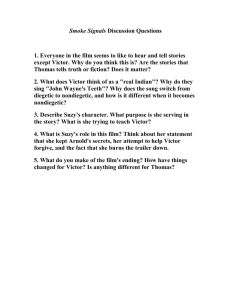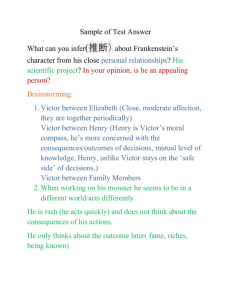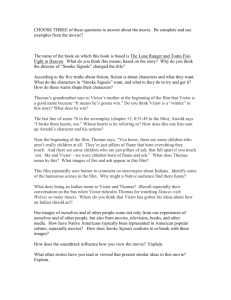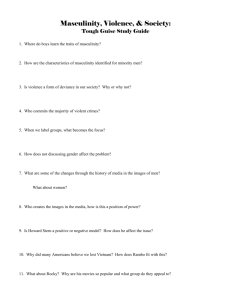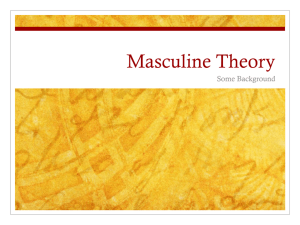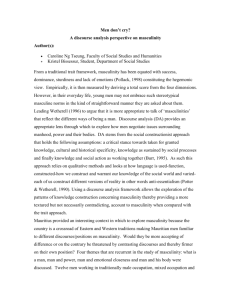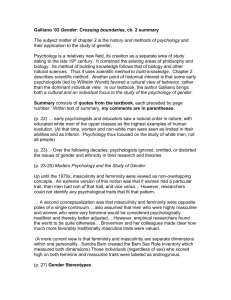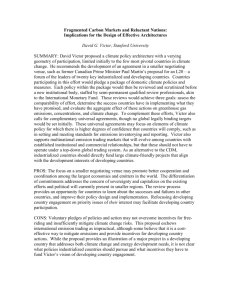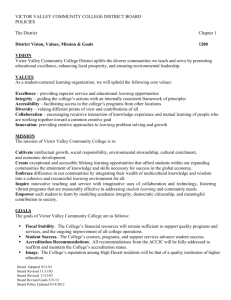Masculinity - bryce's website
advertisement
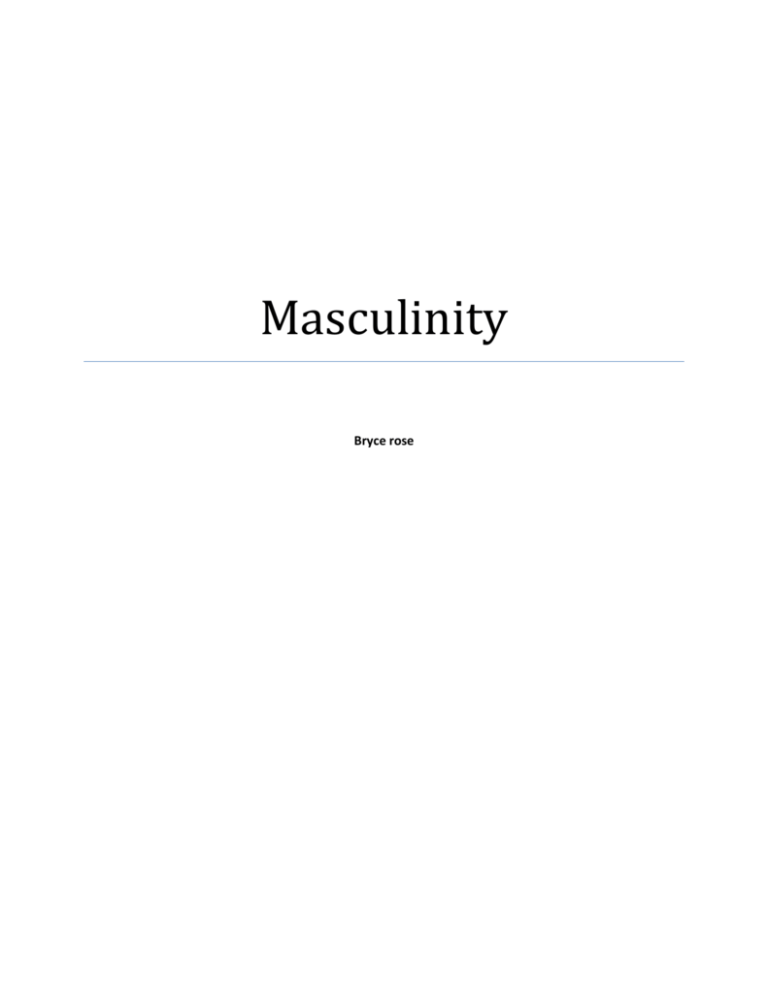
Masculinity Bryce rose The term masculinity is thrown around a lot to sum up different characteristics of being a man. Many of the characteristics are very universal. What is considered masculine in Africa will be very similar to what is considered masculine in Asia, or Europe. Masculinity is not something that just happens, it is taught either through culture, or necessity. Masculinity represents more than just an outward appearance of aggression or strength. It is also the unseen internal conflict between strength and compassion, confidence and insecurity, and cultural stigmas. Every person has a slightly different definition of what masculinity is. A person’s up bringing plays a powerful role in the development of the idea of masculinity. A person brought up in a gated community is going to have a different outlook of masculine characteristics then a person brought up in a rough community, or a farming community. The traditional core characteristics of masculinity are strength, solidarity, aggressiveness, courage, reliability, and lack of emotion. In a rough area, or a community that relies on manual labor these masculine characteristics are all but necessary for daily life, but in a community where physical activity is limited, and security is not major concern masculinity can become more of a negative. Unusual circumstances can cause different masculine traits to become more common in a society as well. Like in the movie zoot suit Henry Reyna displays the ideals of man hood that the turbulent 1940s required but if a man showed the same characteristics today he would be viewed in a very different way. In the movie the quiet man John Wayne is a classic example of the traditional masculine ideals. He is strong, defiant, unrelenting, aggressive, and dominating. In one scene he drags Mary attempts to leave John Wayne’s character Sean. Sean drags her and then forces her to walk to her brother Wills. The on looking crowd encourages Sean behavior. When they arrive at Wills, Sean demands that Will hands over the dowry and then Will and Sean fist fight their way through town and after Will and Sean become friends and everything is happily ever after. The manly traits displayed in this scene show us what used to be the ideal masculine man. The movie smoke signals shows us that the traditional ideas of masculinity are not limited to just our culture. While on the bus heading to phoenix Arizona Victor is trying to tell Thomas how he should carry himself to gain respect. Victor tells Thomas to be stoic. The idea being to act like a stoic Native American warrior. This idea is much the same as the rough quiet cowboy in the quiet man. This scene becomes very interesting when two white men take Thomas and Victor’s seats and Victor attempts to pull the Stoic warrior face on the men. The act fails and leaves Victor looking silly while reinforcing Thomas passive intellectual approach to life. If Thomas would have asked the men the overall result would have likely been the same but asking politely and being declined doesn’t make you look like a jerk. This contrast of approaches shows us a glimpse of the old masculine ideals in Victors approach, and a glimpse of the evolving modern masculine ideals in Thomas. A second scene from smoke signals shows us an aspect of traditional masculinity that is often not talked about but transcends all cultures and is also an important leadership characteristic. When Victor and Thomas finally arrive at Arnold’s trailer, Arnold is Victor’s father. Victor and Thomas meet Suzie who was a friend to Arnold before he died. Suzie tells Victor many things about his father some good and some bad. She tells Victor the true story behind the fire that killed Thomas parents. She tells him how Arnold set the house on fire by accident when he was drunk and then started to run away. Arnold then turned back and when he arrived back at the house Thomas parents threw Thomas from the second story window. Arnold caught Thomas and was heralded as a hero. Arnold was the only one that knew that he was responsible for the fire in the first place. This story along with other stories Suzie tells Victor stirs him emotionally. Victor holds his emotions in and when he does express them it comes out as anger. Finally Victor works up the courage to enter his father’s trailer. Suzie shows him the trailer and then leaves him alone inside. A torrent of emotion comes out once he is alone. He is expressing all of the repressed emotions that he has kept in over the years. The repressed emotions that have caused him to feel so much anger now being released allows him to begin the healing process. Victor cuts off his long hair which is a symbol of letting go of the past. This moment in the movie gives the feeling of a new beginning for victor. The movie zoot suit is another film that offers an interesting look at masculinity. Henry Reyna play the role of a conflicted young male in the turbulent 1940’s. The movie is set in Los Angles during World War II. During this time Los Angles is a bad place to be if you are Hispanic. Persecution and violence is everywhere. In the fight scene in the dance hall we get to see a good example of the internal conflict of masculinity. A fight breaks out between two Chicano gangs and US service men. The fight escalates into a knife fight. Henry engages the leader of the other Chicano gang soon after henry has his switchblade to the man’s neck. At this point the movie freezes and el Pachuco enters telling Henry that this is just what the movie need two dead Mexicans. This shows us the internal conflict that Henry faces. As a man and as a leader he can’t be seen as weak. He has no real desire to kill the man but has to find a way to not kill him and still be seen as a strong man. He removes his switchblade from the man’s neck showing compassion. Henrys gang begins to celebrate the victory and Henry quickly silences them and has them leave. In two gestures removing the knife from the man’s neck, and stopping his gang from taunting the others in defeat. Henry shows us that traditional masculine ideals can be put aside for more compassionate and thought out methods. Ultimately to sum up the term masculinity in a way that would always be true is not logical. Masculinity envelops more than just outward brute characteristics. Masculinity is more of the internal struggles that are faced to suppress emotions and make decisions that are not for self but for community like henry in zoot suit, or to struggle with social stigmas that tell you that you have to act in a way that has no premise in reality like victor in smoke signals. His stoic warrior outlook prevents him from expressing his emotions causing him to express himself with anger. In the end masculinity will continue to show itself in different mediums and we as a society will continue to change the way we view it with time and circumstance.
